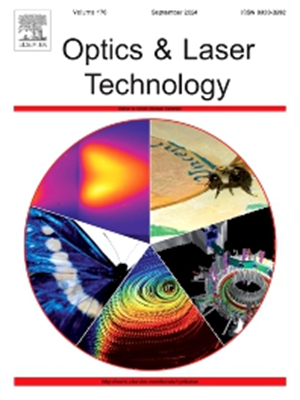Frequency-shifted laser feedback interferometry in non-planar ring oscillators
IF 5
2区 物理与天体物理
Q1 OPTICS
引用次数: 0
Abstract
Laser feedback interferometry (LFI) has a wide range of applications such as displacement, distance and velocity measurements. LFI has been realized in many types of lasers but has never been reported in non-planar ring oscillators (NPROs) to the best of our knowledge. Here, we present a new type of LFI based on an NPRO laser. The intrinsic resistance to optical feedback in NPROs is broken under weak-magnetic-intensity condition, where stable bidirectional lasing is initiated in the ring cavity. The interference signal, i.e., the beat of the bidirectional lasing is with frequency in the range of a few hundred kilohertz, which is mainly determined by the applied magnetic intensity in NPRO. Frequency-shifted LFI is thus constructed in NPRO without using acousto-optic modulators as mostly used in conventional LFI. A theoretical model based on dual-frequency rate equations and Lang–Kobayashi equation is presented to describe the mechanism of LFI in NPRO. In the end, micro-vibrational measurements are demonstrated to prove the potential application, where vibration-detection amplitude limit is sub-picometer, and the detection frequency range from kilohertz to a few hundred kilohertz is achieved. Benefiting from the characteristics of tiny footprint, ruggedized structure, long lifetime and ultralow-noise of NPRO lasers, NPRO-based LFI may find important applications in industry, scientific research, military and aerospace.
非平面环形振荡器中的频移激光反馈干涉测量
激光反馈干涉测量(LFI)在位移、距离和速度测量等方面有着广泛的应用。LFI已经在许多类型的激光器中实现,但据我们所知,在非平面环形振荡器(NPROs)中从未报道过。在这里,我们提出了一种基于NPRO激光器的新型LFI。在弱磁场条件下,环形腔内产生稳定的双向激光,破坏了NPROs对光反馈的固有阻力。干扰信号,即双向激光的节拍,频率在几百千赫兹范围内,主要由NPRO中的外加磁场强度决定。因此,在NPRO中构建了频移LFI,而不使用传统LFI中常用的声光调制器。提出了基于双频速率方程和Lang-Kobayashi方程的理论模型来描述NPRO中LFI的机理。最后,通过微振动测量证明了该方法的潜在应用,其中振动检测幅值限制为亚皮米,检测频率范围从千赫兹到几百千赫兹。得益于NPRO激光器占地面积小、结构坚固、寿命长、超低噪声等特点,基于NPRO的LFI将在工业、科研、军事和航空航天等领域得到重要应用。
本文章由计算机程序翻译,如有差异,请以英文原文为准。
求助全文
约1分钟内获得全文
求助全文
来源期刊
CiteScore
8.50
自引率
10.00%
发文量
1060
审稿时长
3.4 months
期刊介绍:
Optics & Laser Technology aims to provide a vehicle for the publication of a broad range of high quality research and review papers in those fields of scientific and engineering research appertaining to the development and application of the technology of optics and lasers. Papers describing original work in these areas are submitted to rigorous refereeing prior to acceptance for publication.
The scope of Optics & Laser Technology encompasses, but is not restricted to, the following areas:
•development in all types of lasers
•developments in optoelectronic devices and photonics
•developments in new photonics and optical concepts
•developments in conventional optics, optical instruments and components
•techniques of optical metrology, including interferometry and optical fibre sensors
•LIDAR and other non-contact optical measurement techniques, including optical methods in heat and fluid flow
•applications of lasers to materials processing, optical NDT display (including holography) and optical communication
•research and development in the field of laser safety including studies of hazards resulting from the applications of lasers (laser safety, hazards of laser fume)
•developments in optical computing and optical information processing
•developments in new optical materials
•developments in new optical characterization methods and techniques
•developments in quantum optics
•developments in light assisted micro and nanofabrication methods and techniques
•developments in nanophotonics and biophotonics
•developments in imaging processing and systems

 求助内容:
求助内容: 应助结果提醒方式:
应助结果提醒方式:


